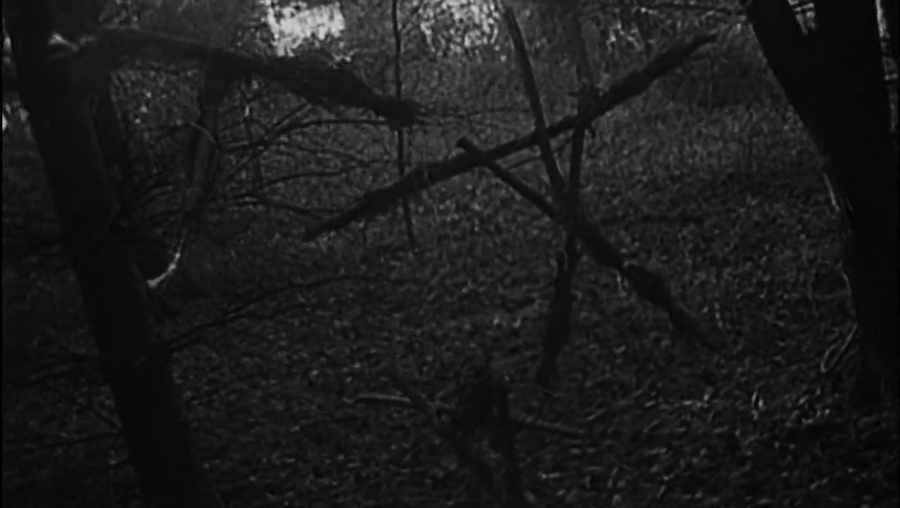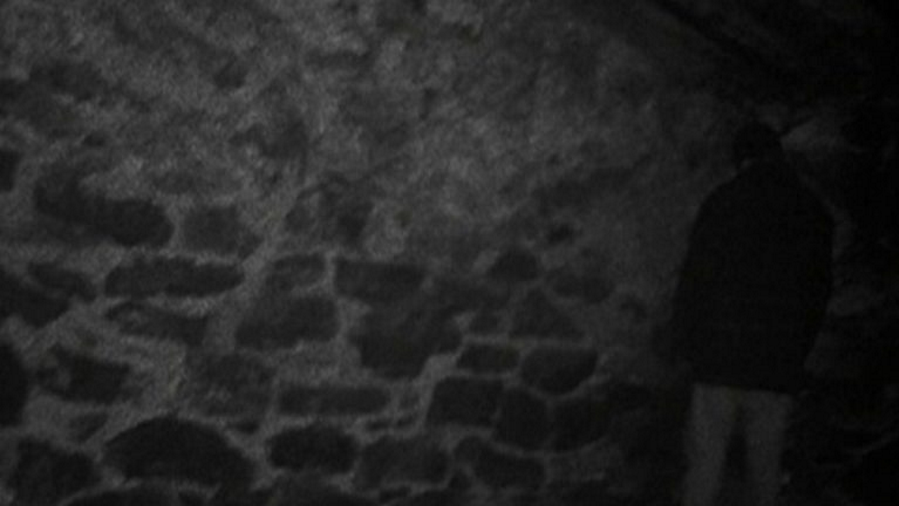THE BLAIR WITCH PROJECT
Directed by Daniel Myrick and Eduardo Sanchez. 1999. United States.

I. THE BLAIR WITCH PROJECT IS BORING!!!
Or so say an army of teens and early 20-somethings online these days. I don't blame them for thinking that. Hell, I can imagine for folks like them, yes, it is quite boring.
The style of THE BLAIR WITCH PROJECT has become the style of PARANORMAL ACTIVITY. Both films feature characters trapped in some sort of haunted house story they cannot escape, spending their days dreading the nighttime assaults from forces beyond their comprehension. But PARANORMAL ACTIVITY only borrows from the artistic and stylistic platform devised by Eduardo Sanchez and Daniel Myrick. It doesn't seek to emulate it perfectly. So instead of quiet, you get jump scares. Instead of characters actively trying to escape from their hell, you have characters all but wallowing in it. And instead of the beating heart of spontaneous film making, you have the cold and predictable hand of structure-minded screenwriters guiding the whole thing along.
Much like the films that came after HALLOWEEN, the films inspired by THE BLAIR WITCH PROJECT seem to misunderstand just what it was that made the film so powerful. They get caught up in the apparent ease of replicating the films success. All you need is a man in a mask stalking teenagers, right? All you need are a bunch of fresh-faced actors with a camcorder, right? Well, no. You need more than that. Because the man in the mask or the kid with the camcorder… that's just a single element, not the whole. And truth be told, while the majesty of THE BLAIR WITCH PROJECT is still largely intact, much of what made the film so powerful back in 1999 wasn't just the images on the celluloid.
II. IT WAS THE “EXPERIENCE”
The internet was only four years into its commercialization. It was, by then, mainstream enough, but viral marketing was still a new and exciting way to promote all kinds of products. Sanchez and Myrick took full advantage of this new marketing scheme, creating a whole mythos behind their little low budget horror film. When I first heard of THE BLAIR WITCH PROJECT, it was in a blurb in Premiere Magazine. The film had just played Sundance and was picked up for distribution by Artisan. Though there were no details given as to what the film was about, there was a website listed. Curious, I decided to check it out and man, oh man, did I love what I found.

Here was an entire back story, complete with snippets of urban legends, police reports, “crime scene” photos… You felt like you were stumbling upon some great mystery. I remember waiting 15 minutes (I do not miss dial-up internet) just to watch some embedded QuickTime video about the unsolved disappearance of three documentary filmmakers in the Maryland woods. It was a fresh and fascinating way to market a movie. Seeing the film on its opening night was like finally finding that missing piece of a puzzle, even if the finale brought with it suggestions of an even deeper mystery, one that would never be solved. I was terrified by the film. I was convinced by the film. But more than that, I was impressed with the film.
I have to wonder if anyone else in the theater had the same experience I did. Truth be told, seeing THE BLAIR WITCH PROJECT without any knowledge of the fictional back story is to only see half the film. Artisan clearly knew this as a SciFi Channel special, The Curse of the Blair Witch, a more traditional re-telling of the information contained on the website, was aired shortly before release. All of this appealed to me greatly. Here it was, the first true combination of visual media, the traditional cinema presentation of a guerrilla-style film complimented by the new media of the internet.
Around the same time, another film was released called THE LAST BROADCAST. Stefan Avalos and Lance Weiler's faux documentary about the deaths of a handful of amateur documentarians bears a striking surface resemblance to THE BLAIR WITCH PROJECT. Both are about college-age filmmakers exploring urban legends (in the case of THE LAST BROADCAST, the Jersey Devil), both were low budget efforts, both took advantage of new media. These days, the two films are linked together because of these coincidences, but they're completely different experiences in both construction and execution. THE LAST BROADCAST is every inch the mockumentary and is saddled with a fourth wall breaking ending that saps most of the strength out of the film.
It's a film about a mystery, rather than part of a mystery. It offers a concrete solution, rather than merely ending without comforting closure. It's a good film, but not nearly as great as its counterpart and I think the main reason for that comes down to that one crucial element that really made THE BLAIR WITCH PROJECT so damn brilliant.
III. THE FOUND FOOTAGE ANGLE
Believe it or not, this was considered fresh and new back in 1999. Far from the first movie to utilize it (CANNIBAL HOLOCAUST and MAN BITES DOG both spring to mind), the presentation of the material struck a cord with moviegoers. Today, it seems so cheap and gimmicky, but when used correctly, the found footage format can add two incredibly important elements to a film: authenticity and immediacy.
CLOVERFIELD is many things. Authentic is not one of them. Found footage was used solely to provide a sense of immediacy. I don't care how preoccupied you are, you WILL notice a couple tanks and four dozen soldiers coming up the street behind you. The characters in CLOVERFIELD do not, only reacting when a monster's foot plops down in front of them and the battalion behind them opens fire. Matt Reeves didn't care about authenticity (if he did, we wouldn't have a great film marred by a scene like Hud not noticing the gigantic monster standing behind him after the helicopter crash). He cared about immediacy.
Sanchez and Myrick cared very much about authenticity in their film. The entire production was built around aiding the creation of that authentic atmosphere. Actors were not given a script, only confidential notes dictating speaking points, a general attitude and one or two hidden motivations. The actors were guided from point A to point B via GPS instructions, were not allowed to break character if a camera was on and were required to improvise all dialogue. They really were toyed around with at night and to accentuate their performances, as the grueling eight day shoot went on, their provisions were reduced to little more than an apple, some water and a protein bar.
This is that beating heart of spontaneous film making I spoke about earlier. The characters here don't have arcs, they have breakdowns. As the film progresses, they switch from being antagonistic to pragmatic and then back again. They bicker and argue. For some people, the characters are the big turn-off here, largely because they're not really “movie characters”. Heather, Josh and Mike are not traditional audience surrogates. We too are annoyed by Mike's rashness, Josh's constant badgering and Heather's f oolishness. If you find yourself getting annoyed by their endless bitching and walking in circles, the film is working as intended.

The found footage angle works so well in THE BLAIR WITCH PROJECT precisely because it creates both a genuine sense of immediacy AND a genuine sense of authenticity. We're trapped with these people and their attitudes grate on us the same way they grate on one another. We want out of these woods. We share the frustration and the exhaustion. We fear the oncoming night as much as they do. We're not apart from the group. Rather, we're a part of the group. In a sense, the camera isn't just some object filming all this stuff. It's us.
IV. WE ARE THE CAMERA
Overcoming the underlying gimmick of the found footage movie is a tricky feat. “Why don't they just stop filming?" is a question that comes up time and time again with these movies, even though the internet shows us that people will NEVER stop filming, no matter how grim the circumstances. People walked through the streets on Bastille Day with their cell phones, stopping to document the wreckage of each human body they came across. People stood still and filmed as terrified victims jumped from the Twin Towers. We don't turn the cameras off when shit hits the fan. We turn them on.
Stan Brakhage once remarked that if it were not for his camera, he would have not been able to continue filming the autopsy footage that comprises the entirety of his documentary, THE ACT OF SEEING WITH ONE'S OWN EYES. The camera as an abstraction device is given weight throughout THE BLAIR WITCH PROJECT. Josh refers to it as a “filtered reality” and concludes that by using the camera so heavily throughout their experience, Heather is seeking to somehow escape the hell of their circumstances. This is somewhat analogous to how war photographers often describe their experiences. They're not photographing dead bodies torn apart by shrapnel or bullets. They're just photographing collateral damage.
But we are not capable of abstraction. As viewers, the “filtered reality” of the characters is our actual reality. The central concept of the film, that what we are watching is the found footage of people who are missing, presumed dead, re-frames the experience from a simple horror film to something worse. We're standing in that morgue alongside Brakhage. What we're watching is an autopsy.